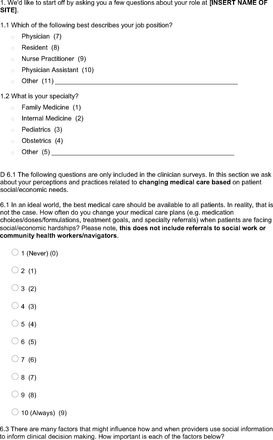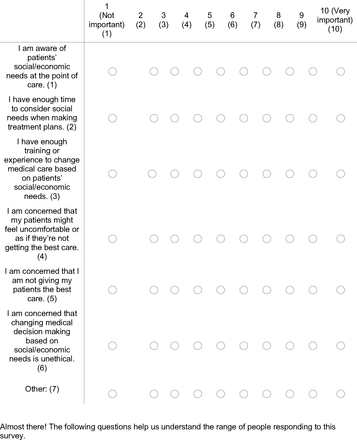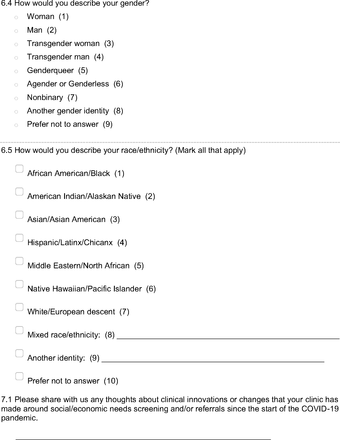Abstract
Background: Social risk data collection is expanding in community health centers (CHCs). We explored clinicians’ practices of adjusting medical care based on their awareness of patients’ social risk factors—that is, changes they make to care plans to mitigate the potential impacts of social risk factors on their patients’ care and health outcomes—in a set of Texas CHCs.
Methods: Convergent mixed methods. Surveys/interviews explored clinician perspectives on adjusting medical care based on patient social risk factors. Survey data were analyzed with descriptive statistics; interviews were analyzed using thematic analysis and inductive coding.
Results: Across 4 CHCs, we conducted 15 clinician interviews and collected 97 surveys. Interviews and surveys overall indicated support for adjustment activities. Two main themes emerged: 1) clinicians reported making frequent adjustments to patient care plans based on their awareness of patients’ social contexts, while simultaneously expressing concerns about adjustment; and 2) awareness of patients’ social risk factors, and clinician time, training, and experience all influenced clinician adjustments.
Conclusions: Clinicians at participating CHCs described routinely adjusting patient care plans based on their patients’ social contexts. These adjustments were being made without specific guidelines or training. Standardization of adjustments may facilitate the contextualization of patient care through shared decision making to improve outcomes.
- Community Health Centers
- Health Disparities
- Health Equity
- Outcomes Assessment
- Patient-Centered Care
- Shared Decision-Making
- Social Determinants of Health
- Social Risk Factors
- Surveys and Questionnaires
- Texas
Introduction
The health care sector’s dual aims of improving care equity and quality1 have increased efforts to integrate social and medical care.2–6 A key component of this integration involves applying information about patients’ social risk factors to clinical care to mitigate the potential negative impacts of social risks on patients’ care and health outcomes.7 This is especially timely given that collection of social risk data are increasingly incentivized by both state and national health care payers and accreditation bodies through standardized screening efforts.8–10 Sometimes referred to as “social care adjustment” in the literature, tailoring care based on information about patients’ social conditions can include a wide range of clinical decisions and activities. These might include changing a patient’s insulin dose based on food access to mitigate the risk of hypoglycemia or enabling walk-in visits for patients who lack reliable transportation.7,11,12 Social care adjustments can complement efforts to connect patients with social services, though connections to social services have been the disproportionate focus of existing social care outcomes research.13–20 Relatively little research has in parallel examined how the growing availability of social risk information may also influence clinical decision making.21–25 This brief report explores both clinicians’ practices and perspectives on social care adjustment in 4 Texas community health centers (CHCs).
Methods
This is an analysis of data collected to understand the barriers and facilitators to social care activities at Texas community health centers (CHCs). Data recruitment and collection methods have been reported previously.26 This report focuses exclusively on clinician perspectives on clinical care adjustments, whereas the original study was designed to more broadly explore social care practices. All study activities were approved by the University of California, San Francisco Institutional Review Board.
Data Sources
We used a convergent/concurrent mixed methods approach that included 1) semistructured interviews and 2) surveys with clinicians. Recruitment was done through e-mail by study staff using a list of eligible participants at each study site. Clinicians included physicians, nurse practitioners (NPs), physician assistants (PAs), and dentists. We aimed to recruit a convenience sample of 4 clinicians for interviews from each site based on prior experience reaching thematic saturation.27 Interviews were conducted by trained study staff, and took approximately 45 to 60 minutes.26 We invited all clinicians at participating CHCs to complete a Qualtrics survey about adjustment activities.
Surveys were designed to be anonymous to increase respondent comfort responding to survey questions; we could not assess whether all interviewees completed surveys. All data collection and analyses were conducted by the study team. Interviews occurred from November 2020-July 2021; survey responses were collected from November 2020-August 2021. Analyses focused on this report occurred from April to May 2023.
Measures
Semistructured interview guides were designed to explore both perspectives and practices related to adjusting clinical care based on patient social risk information. Clinician surveys asked about individual adjustment practices. (Appendix 1 includes full text of interview guides and surveys.) Survey questions used 10-point Likert scales about frequency of making adjustments based on patients’ social risks (1 = Never, 10 = Always), and the importance of different factors in influencing adjustment decision making (1 = Not important, 10 = Very important).
Data Analyses
Details about interview transcription and coding have been published elsewhere.26 In brief, 3 study researchers developed the preliminary codebook (EHD, BA, NR), which was then applied to all transcripts by 2 researchers (EHD, BA) who met to discuss and resolve discrepancies with the broader research team as needed.26 In this report, we focused on codes related to clinical adjustment, defined as making changes to medical care plans based on knowledge of patients’ experience of social risks. Basic thematic analysis and constant comparative methods were used to analyze transcripts.28 Survey data were analyzed using descriptive statistics. Interview and survey data were analyzed by the study team first independently and then in comparison, to complement and inform each other. Relevant survey items were identified and compared/contrasted to interview themes after interviews were coded. We followed guidelines for reporting findings from mixed methods studies,29 as well as recommendations for data integration using joint displays.30,31
Results
We interviewed 15 clinicians; 97/321 eligible clinicians completed surveys (average response rate 30%; range by CHC 25 to 47%). See Table 1 for participant demographics. Additional data on study CHCs is available in a related publication.26 Two main themes emerged across surveys and interviews: 1) clinicians reported making frequent adjustments to patient care plans based on their awareness of patients’ social contexts, while simultaneously expressing concerns about adjustment; and 2) awareness of patients’ social risk factors, and clinician time, training, and experience all influenced clinician adjustments. See Table 2 for thematic results joint display, including representative quotes.
Demographics of Participating Clinicians at Four Texas Community Health Centers (CHCs)
Study Themes with Supporting Data
Theme 1: Clinicians reported making frequent adjustments to patient care plans based on their awareness of patients’ social contexts, while simultaneously expressing concerns about adjustment
All interviewees acknowledged that patients experienced multiple forms of social risks that impacted health care access and quality. Clinicians often initially struggled to conceptualize and define social care adjustments, yet universally described examples of adjustments they were routinely making, especially related to medication prescribing practices. Less consensus emerged in interviews about ways clinicians should use information about patients’ social risks in clinical decisions. In clinician surveys, 25% of respondents reported always adjusting medical care based on patients’ social needs; 5% noted never making adjustments. When asked about factors that influenced their decisions around making adjustments, respondents were most concerned about quality of care (mean, 7.1/10 importance), followed by concerns about patient comfort/satisfaction (mean, 6.1/10 importance) and that adjusting care was unethical (mean, 5.8/10). Few interviewees explicitly referenced including patients in shared decision making around clinical care adjustments based on social conditions, but among clinicians who voiced concerns about adjustments, shared decision making was acknowledged as a possible way to mitigate risks to quality of care. (Table 2)
Theme 2. Awareness of patients’ social risk factors, and clinician time, training, and experience all influenced clinician adjustments
Surveys suggested that the most important factor that affected clinician decision making about adjustments was being aware of patients’ social conditions at the point of care (mean, 8.3/10 importance), followed by clinician time, training, and experience to make adjustments (mean, 7.8/10 importance) (Table 2). In interviews, while clinicians reported confidence that their existing relationships with patients/families ensured they were familiar with their patients’ social contexts, they in parallel indicated that the availability of patients’ responses to social risk screening forms helped them to make clinical care adjustments. In interviews, commonly endorsed facilitators for medication adjustments (eg, strategies to decrease patients’ out-of-pocket medication costs) were the availability of CHC-based pharmacies, embedded clinical pharmacists, or clinician knowledge of pharmacies with low-cost medication lists.
Discussion
Our findings from surveys and interviews with clinicians working in 4 Texas CHCs are largely consistent with other studies indicating that clinicians at CHCs are adjusting their medical care based on information about patients’ social conditions.24 Our findings suggest, however, that social care adjustments are highly clinician-dependent both in terms of how frequently and how it is done (eg, degree to which shared decision making is included). If awareness of patients’ social risks increases clinicians’ delivery of patient-centered care and shared decision making based on identified social risks, adjustment activities may positively impact patients’ care.
Conversely, social care adjustments have the potential to perpetuate health disparities or inequitable standards of care for patient populations that experience marginalization, including discriminatory practices stemming from interpersonal or structural racism. Related, emerging literature that patients are not being screened for social risks at equal rates based on their preferred language, age, race, and ethnicity,10,26,32 raises concerns that not all patients may equally benefit from adjustments, given our finding that social risk screening facilitated clinician adjustments activities. The dependence of adjustment activities on having information about patients’ social risks at the point of care has implications for the implementation and documentation of patient social risk screening. Future studies should explore the patient and clinician impacts of adjustments made based on information about patients’ social conditions and explore ways to standardize adjustment decision making in ways that can maximize their benefits and avoid harms. Standardized social care interventions tracking based on social risks may help us better understand and standardize adjustment activities. Shared decision making is a potential solution to avoiding harms from adjustments, but shared decision making needs to be informed by a recognition that it can also be influenced by structural racism.33,34
The preponderance of adjustment activities focused on medication access raised by interviewees underscores that clinical teams are eager to expand access to low-cost pharmaceuticals. This may be especially important in states like Texas that have not expanded Medicaid. Given that close to 10% of Americans report not taking prescribed medications due to cost—a percentage that is higher for those with disabilities and inadequate insurance coverage35—adjustments may be one avenue to assist patients and their care teams in contextualizing and improving accessibility of care.
More attention to defining a suite of impactful clinical adjustments that should be considered for patients experiencing financial strain will likely lead to more uptake. Clinical activities to mitigate the impact of social adversity on health outcomes will always need to be accompanied by more widespread structural changes that work at the community level to improve living conditions.
Limitations
First, this a study of 4 urban/suburban CHCs in Texas, which limits its generalizability both to other geographies and populations and to non-CHC health care settings. It is similarly subject to participation bias related to both CHC and individual participant decisions to participate. Survey response rates were low. Second, by design, the wording of questions about adjustment in the survey contained more explanation/examples as compared with the initial probe used in interviews. A less explicit explanation of adjustment in initial interview probing may have contributed to clinicians’ challenges conceptualizing adjustment. Third, the convergent/concurrent mixed methods design precluded us from following up with interviewees about what ethical concerns they may have had about adjustment when completing the surveys. Similarly, we did not ask about shared decision making in the survey, nor explicitly ask about it in interviews, which would have expanded our understanding of clinicians’ perspectives on its role in mitigating potential harms of social care adjustments. Finally, patients were not included in this study.
Acknowledgments
We would like to thank the staff, leadership, and providers at the participating CHCs for their contributions to this study and moreover for their steadfast commitment to their patients. We also appreciate Nina Singh and Carlos Nguyen’s contributions to study coordination and data cleaning. This work was supported by the Episcopal Health Foundation (EHF). The views presented here are those of the authors and not necessarily those of EHF, its directors, officers, or staff. EHF had no role in study design and conduct of the study; collection, management, analysis, and interpretation of data; preparation, review, or approval of the manuscript; or decision to submit the manuscript for publication. E.H.D. had full access to all the data in the study and takes responsibility for the integrity of the data and the accuracy of the data analysis. N.R. was funded through UCSF’s Institute for Health Policy Fellowship (AHRQ 5T32HS022241-08) during the data collection of this project and currently funded through the Clinical and Translational Science Center at the University of California, Davis (KL2R001859). B.A. was funded by NIH FIRST program under the National Cancer Institute (U54CA267789). M.J. was employed by the National Association of Community Health Centers during data collection for this study.
Appendix. Clinician Interview Guides and Survey Tool
Appendix 1a. Clinician Key Informant Interview Guide
Appendix 1b. Clinician Survey Questions Relevant to Adjustment
Notes
This article was externally peer reviewed.
Funding: This work was supported by the Episcopal Health Foundation (EHF).
Conflict of interest: None.
To see this article online, please go to: http://jabfm.org/content/37/3/466.full.
- Received for publication August 2, 2023.
- Revision received October 19, 2023.
- Accepted for publication October 20, 2023.












